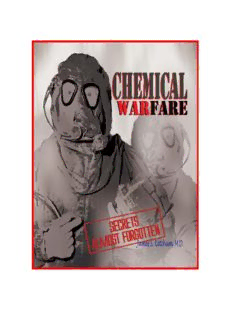
Chemical Warfare Secrets Almost Forgotten PDF
Preview Chemical Warfare Secrets Almost Forgotten
CHEMICAL WARFARE SECRETS ALMOST FORGOTTEN A Personal Story of Medical Testing of Army Volunteers with Incapacitating Chemical Agents During the Cold War (1955-1975) by James S. Ketchum, MD Witha forewordby AlexanderShulgin,PhD Copyright ©2006byJamesS.Ketchum Allrightsreserved. PublishedbyChemBooksInc. 2304FairbanksDrive SantaRosa,California 95403 ISBN#978-1-4243-0080-8 RegistrationNumberTXu -1 -333–097 EffectiveDateofRegistration11Dec 2006 CoverdesignbyJimO’Neil Dedicated to My loving wife Judy Ann (Schaller) Ketchum who helped and encouraged me to undertake and complete this book TABLE OF CONTENTS Foreword– AlexanderShulgin,PhD Prologue:HotNightinHalifa 1 ColdWar–ChemicalCalltoArms 1 2 IncapacitatingTheEnemyStrangeFruitandStraySmoke 9 3 Hello,EdgewoodArsenal 17 4 TheVolunteers:HumanGuineaPigs– Not! 29 5 AnInterestingDrugtoStartWith 35 6 BZ:TinyBaseballGamesandDC-3’sonaPaddedFloor 43 7 LSD:TheOtherAcidTest 53 8 WorkingOuttheKinks 69 9 BusyasaBeeonaDoseofBZ 81 10 MoreBreedsthanataDogShow 97 11 TamingtheFractiousBelladonnoids 109 12 AlteredStatesInFishTanksandFieldTests 117 13 NameYourPoison:SafetyFirstandAlways 127 14 ProjectDork:SoldieringonBZintheUtahDesert 141 15 RummagingThroughtheCloset 153 16 Post-DocwithPribram 171 17 EdgewoodAgain:HopingforDéjàVu 181 18 GoodandBadVibrationsWithinandWithout 193 19 RearrangingtheDeckChairs 201 20 FinalDaysatEdgewood 207 21 CIAConnections:NowYouSeeThem,NowYouDon’t 217 22 OnIntothe70sand80s 227 23 TotheEndoftheCenturyandBeyond 235 24 BelatedAlarms:WhatHaveWeDone? 243 25 ChemicalWarfareThenandNow: ARealityCheck 257 Appendix 269 FOREWORD My first two interactions with the world of US Government chemical warfare were in the 1950s or maybe the 1960s when I was still a senior research chemist at the Dow Chemical Company in the San Francisco Bay Area. They were totally opposite in the images of secrecy and research process that they presented. I kept no notes, so all is from ancient memory. The first meeting was with two or three chemists in dark suits and ties who were introduced to me and a half dozen other research chemists as being government researchers in the area of potentially interestingsynthetic organic chemicals. We were not told from which laboratory they came and the only clues to their areas of interest were two synthetic reaction sequences which had been drawn on the conference room blackboard. The man with the chalk told us that these two pictures had been worked out successfully, and their question was: could any of us propose a last step which might link them together. The bottom compounds in the two schemes were followed by arrows which pointed to an empty area at the bottom of the blackboard. I asked them why not draw in the structure of the desiredproduct andtheysaidthat theywerenot at libertytodoso. "Oh, nonsense," I said and got up and went to the blackboard and drew the structure of the target. I drew the isomeric homologue of tetrahydrocannabinol with the terpene double bond down in the terpene 3,4-position and a 1,2-dimethylheptyl chain at the aromatic 3- position. "This is the obvious product you want," I added as I returned to my seat, "So why don't we discuss how this coupling could beachieved." There was an unmistakable discomfort shared by the gentlemen from Washington. After a bit of discussion I volunteered the statement, "Of course, with three chiral centers, there will be eight distinct optical isomers possible, all of different pharmacology, and some may not resemble marijuana at all in action." The meeting broke up shortly thereafter. A lot of things just couldn't be talked about. The second meeting occurred at an informal conference with some thirty people present, located at a retreat north of Los Angeles. This was organized by my good friend (and secret trumpet player) Daniel H. Efron, MD, PhD (1913-1972). This get-together was sponsored by the Washington operation he ran, the Pharmacology program at the National Institute of Mental Health. He told me to sit over there, pointing to an interesting looking man who was a total stranger. We introduced ourselves. I said my name was Sasha Shulgin, and he said his name was Van Sim. "Oh," I asked him, "What is your first name?" "Van is my first name -- I am Van M. Sim." We quickly discovered that we were both fascinated by psychedelics (they were called psychotomimetic drugs at that time) and that we were both personally experimenting with them. My art was the synthesis of new ones to compare the difference in activity due to structural changes (this at my laboratory at Dow and in my basement lab at home) and his curiosity was met by varying not the compound so much as the setting and the immediate environment around him (this at his laboratory at Edgewood Arsenal). Oh! A government scientist with whom there was nothing in the world that couldn't be talkedabout. Thus, this foreword is intended to prepare the reader for a story that has never before been told, the telling of the history, the origins and the development of the physical structure and the variety of people who worked at both the Edgewood Arsenal and its precursor, the Army Chemical Center. This it indeed does, with a flood of photographs and names and candid viewings of the people who worked there during the 11 or so years that Jim Ketchum was a major research person in the medical section. There is a mass of small detail, ranging from unexpected visits and unusual interviewsto the conversations taking place during some of the drug experiments with volunteer subjects. This is an intimate portrayal of the structure of the research group, and the slow but inevitable changes in attitudes andresearch goals that occurredovertime. But to me, this book is much more than an introduction to the EdgewoodArsenal. It is anautobiographyoftheauthorhimself,from a young man with a developing medical career to an older, articulate analyst of today's world of chemical weapons in general, but particularlythe instruments ofpsychochemical warfare. It is apleasuretobeable tocontributetothis story. AlexanderT.Shulgin,PhD
